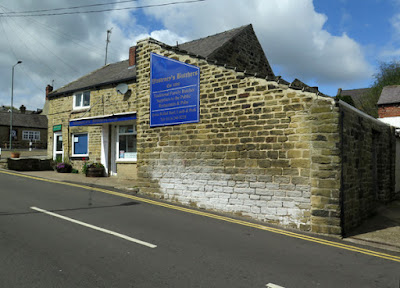 |
| The Old Harrow public house |
Having completed the section of the Sheffield Round Walk that runs clockwise from Chancet Wood to the bottom of the Porter Valley and explored the village of Norton, where I encountered various examples of what I have assumed to be Grenoside Sandstone, I continued my investigation of the building stones of Sheffield with a trip to the village of Grenoside itself.
 |
| The geology around Grenoside |
The origin of the name Grenoside, which is said to mean ‘a quarried hillside’, goes back to Saxon times and the various quarries here produced grindstones, furnace linings and chests for the cementation process of making steel. It also produced good quality building stone, which has been used throughout the village for the older houses, chapels and churches, the old infants school and in various public houses.
 |
| A sculpture by Andrew Vickers in Grenoside Green |
Although a Conservation Area Appraisal mentions that Grenoside Sandstone has been used at Hillsborough Barracks and for fine ashlar at the Old Post Office, in Sheffield city centre, the historic buildings of Grenoside itself are not considered to possess much architectural merit. It is not mentioned in my copy of Pevsner’s guide to the historic buildings of the West Riding of Yorkshire and it possesses only one listed building.
 |
| Grindstones set into a wall on Norfolk Hill |
When living in nearby High Green many years ago, I once visited Grenoside to see its Sword Dance and passed through it a couple of times on my way to Oughtibridge and I have always thought that it is a good looking village, but I had never taken a walk around it.
 |
| Edwardian purpose built commercial premises on Norfolk Hill |
The last quarry closed in about 1939 and those that are marked on old maps have now been infilled and redeveloped for housing and, although a few downloaded guides to the archaeology and history of Grenoside helped me to identify a few old quarries in the woods north of the village, on this occasion I didn’t set out to explore them.
 |
| The old infants' school on Norfolk Hill |
In the absence of exposed rock faces, an exploration of historic buildings, walls, kerbs, roofing flags and various other structures provides a good introduction to the physical characteristics, which make the sandstone here sufficiently different to other Lower Coal Measures sandstones to be considered a type locality and named the Grenoside Sandstone.
 |
| The principal building of the old infants' school on Norfolk Hill |
The British Geological Survey memoir states that “as a rule this rock is remarkably micaceous and fissile” making it suitable for roofing tiles and that its micaceous nature makes the Grenoside Sandstone recognisable over considerable areas as a ‘marker horizon’; however, no mention is made of its colour and there is barely a reference to its other physical characteristics.
 |
| Vernacular architecture on Norfolk Hill |
As usual, I had my hand lens and other geologist’s tools with me but I didn’t even touch or closely examine any of the various stones that I saw on the day – instead I just stood back and took a few photographs of my observations.
 |
| Grenoside Methodist Church |
No comments:
Post a Comment